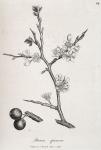
 Also see 085. Prunus domestica. Common prune, or plum tree.
Also see 085. Prunus domestica. Common prune, or plum tree.
Synonyma. Prunum sylvestre. Pharm. Lond.
Prunus sylvestris. Gerard. Emac. p. 1497. Park. Theat. p. 1033. Bauh. Pin. p. 444. J. Bauh. Hist. vol. i. p. 198. Raii. Hist. p. 1527. Synop. p. 462.
Prunus spinosa, foliis glabris serratis ovato-lanceolatis, floribus breviter petiolatis. Hall. Stirp. Helv. n. 1080. Hudson. Flor. Ang. p. 212. Withering. Bot. Arrang. p. 509.
Class Icosandria. Ord. Monogynia. Lin. Gen. Plant. 620.
Ess. Gen. Ch. Cal. 5-fidus, inferus. Petala 5. Drupes nux suturis prominulis.
Spec. Char. P. pedunculis solitariis, foliis lanceolatis glabris, ramis spinosis.
The root is woody, divided, and spreading: the stem is shrubby, crooked, rises to the height of six or eight feet, covered with a purplish black coloured bark, and sends off many irregular spinous branches: the leaves are oval, obtusely lance-shaped, smooth, minutely serrated, of a deep green colour, and stand upon short footstalks: [The serratures of the leaves have been observed by Linnaeus to be terminated by an excretory duct.] the stipulae are linear, notched, and discoloured at their points: the flowers are large, white, and stand separately upon short peduncles: the calyx is small, and divided at the brim into five oval segments: the corolla is composed of five oblong concave petals, attached to the calyx by short claws: the filaments are in number from twenty to thirty, spreading, tapering, white, inserted in the calyx, and furnished with orange coloured antherae: the germen is roundish, the style simple and slender, and the stigma orbicular: the fruit is of the drupous or cherry kind, though much smaller, of a black colour, but covered with a bright blue exudation, and contains a nut with an oblong kernel. It is common in hedges, and the flowers appear in March and April, before the leaves are visible.
The fruit of the Sloe-bush, or, as it is frequently called, Blackthorn, is so harshly sharp and austere as not to be eatable till thoroughly mellowed by frosts: its juice is extremely viscid, so that the fruit requires the addition of a little water, in order to admit of expression. The juice obtained from the unripe fruit, and inspissated to dryness by a gentle heat, is the German acacia, and has been usually sold in the shops for the Egyptian acacia, from which it differs in being harder, heavier, darker coloured, of a sharper taste, and more especially in giving out its astringency to rectified spirit. [Lewis Mat. Med. p. 522.]
The Pruna sylvestria have been employed for their styptic powers since the time of Dioscorides; [Diosc. Mat. Med. Lib. i. cap. 173.] and as their astringency is united to the refrigerant qualities of the fruit, they may sometimes supersede those medicines of this class which are of a resinous or heating quality. They have been recommended in diarrhoeas, hemorrhagic affections, and as gargles, in tumefactions of the tonsils and uvulae. Dr. Cullen considers the Sloe as the most powerful of the fructus acerbi, and adds, that he has often found it an agreeable and useful astringent; but he thinks the conserve of this fruit, as directed by the College, contains a larger proportion of sugar than is necessary. [Vide Mat. Med. vol. ii. p. 41. See J. Bauh. Hist. tom. i. P. i. p. 196. & Fred. Hoffman. Diss. de praestantia remed. domest. §. 26.]
The flowers, with their calyces, are moderately purgative, and for this purpose an ounce infused in a sufficient quantity of water, or rather whey, was experienced to be a pleasant and useful laxative. The powdered bark, in doses of a dram, is said to cure agues.
Dr. Withering says, "The tender leaves dried are sometimes used as a substitute for tea, and is I believe the best substitute that has yet been tried. The fruit bruised, and put into wine, gives it a beautiful red colour, and a pleasant subacid roughness. Letters written upon linen or woollen with the juice of this fruit, will not wash out." Bot. Arr. p. 509.

